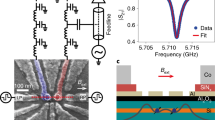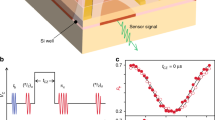Abstract
Electron spins in silicon quantum dots provide a promising route towards realizing the large number of coupled qubits required for a useful quantum processor1,2,3,4,5,6,7. For the implementation of quantum algorithms and error detection8,9,10, qubit measurements are ideally performed in a single shot, which is presently achieved using on-chip charge sensors, capacitively coupled to the quantum dots11. However, as the number of qubits is increased, this approach becomes impractical due to the footprint and complexity of the charge sensors, combined with the required proximity to the quantum dots12. Alternatively, the spin state can be measured directly by detecting the complex impedance of spin-dependent electron tunnelling between quantum dots13,14,15. This can be achieved using radiofrequency reflectometry on a single gate electrode defining the quantum dot itself15,16,17,18,19, significantly reducing the gate count and architectural complexity, but thus far it has not been possible to achieve single-shot spin readout using this technique. Here, we detect single electron tunnelling in a double quantum dot and demonstrate that gate-based sensing can be used to read out the electron spin state in a single shot, with an average readout fidelity of 73%. The result demonstrates a key step towards the readout of many spin qubits in parallel, using a compact gate design that will be needed for a large-scale semiconductor quantum processor.
This is a preview of subscription content, access via your institution
Access options
Access Nature and 54 other Nature Portfolio journals
Get Nature+, our best-value online-access subscription
$29.99 / 30 days
cancel any time
Subscribe to this journal
Receive 12 print issues and online access
$259.00 per year
only $21.58 per issue
Buy this article
- Purchase on Springer Link
- Instant access to full article PDF
Prices may be subject to local taxes which are calculated during checkout




Similar content being viewed by others
Data availability
The data that support the findings of this study are available from the corresponding author upon reasonable request.
References
Veldhorst, M. et al. An addressable quantum dot qubit with fault-tolerant control-fidelity. Nat. Nanotechnol. 9, 981–985 (2014).
Kawakami, E. et al. Electrical control of a long-lived spin qubit in a Si/SiGe quantum dot. Nat. Nanotechnol. 9, 666–670 (2014).
Veldhorst, M. et al. A two-qubit logic gate in silicon. Nature 526, 410–414 (2015).
Maurand, R. et al. A CMOS silicon spin qubit. Nat. Commun. 7, 13575 (2016).
Watson, T. F. et al. A programmable two-qubit quantum processor in silicon. Nature 555, 633–637 (2018).
Zajac, D. M. et al. Resonantly driven CNOT gate for electron spins. Science 359, 439–442 (2018).
Huang, W. et al. Fidelity benchmarks for two-qubit gates in silicon. Preprint at https://arxiv.org/abs/1805.05027 (2018).
Nielsen, M. A. & Chuang, I. L. Quantum Computation and Quantum Information 1st edn (Cambridge Univ. Press, 2004).
Fowler, A. G., Mariantoni, M., Martinis, J. M. & Cleland, A. N. Surface codes: towards practical large-scale quantum computation. Phys. Rev. A 86, 032324 (2012).
Jones, C. et al. Logical qubit in a linear array of semiconductor quantum dots. Phys. Rev. X 8, 021058 (2018).
Barthel, C., Reilly, D. J., Marcus, C. M., Hanson, M. P. & Gossard, A. C. Rapid single-shot measurement of a singlet-triplet qubit. Phys. Rev. Lett. 103, 160503 (2009).
Zajac, D., Hazard, T., Mi, X., Nielsen, E. & Petta, J. Scalable gate architecture for a one-dimensional array of semiconductor spin qubits. Phys. Rev. Appl. 6, 054013 (2016).
Petersson, K. D. et al. Charge and spin state readout of a double quantum dot coupled to a resonator. Nano Lett. 10, 2789–2793 (2010).
House, M. G. et al. Radio frequency measurements of tunnel couplings and singlet–triplet spin states in Si:P quantum dots. Nat. Commun. 6, 8848 (2015).
Betz, A. C. et al. Dispersively detected Pauli spin-blockade in a silicon nanowire field-effect transistor. Nano Lett. 15, 4622–4627 (2015).
Colless, J. I. et al. Dispersive readout of a few-electron double quantum dot with fast rf gate sensors. Phys. Rev. Lett. 110, 046805 (2013).
Gonzalez-Zalba, M. F., Barraud, S., Ferguson, A . J. & Betz, A. C. Probing the limits of gate-based charge sensing. Nat. Commun. 6, 6084 (2015).
Rossi, A., Zhao, R., Dzurak, A. S. & Gonzalez-Zalba, M. F. Dispersive readout of a silicon quantum dot with an accumulation-mode gate sensor. Appl. Phys. Lett. 110, 212101 (2017).
Ahmed, I. et al. Radio-frequency capacitive gate-based sensing. Phys. Rev. Appl. 10, 014018 (2018).
Hill, C. D. et al. A surface code quantum computer in silicon. Sci. Adv. 1, e1500707 (2015).
Veldhorst, M., Eenink, H. G. J., Yang, C. H. & Dzurak, A. S. Silicon CMOS architecture for a spin-based quantum computer. Nat. Commun. 8, 1766 (2017).
Vandersypen, L. M. K. et al. Interfacing spin qubits in quantum dots and donors—hot, dense, and coherent. Npj Quantum Inf. 3, 34 (2017).
Li, R. et al. A crossbar network for silicon quantum dot qubits. Sci. Adv. 4, eaar3960 (2018).
Petta, J. R. et al. Coherent manipulation of coupled electron spins in semiconductor quantum dots. Science 309, 2180–2184 (2005).
Croot, X. G. et al. Gate-sensing charge pockets in the semiconductor qubit environment. Preprint at https://arxiv.org/abs/1706.09626 (2017).
Fogarty, M. A. et al. Integrated silicon qubit platform with single-spin addressability, exchange control and single-shot singlet–triplet readout. Nat. Commun. 9, 4370 (2018).
Hornibrook, J. M. et al. Frequency multiplexing for readout of spin qubits. Appl. Phys. Lett. 104, 103108 (2014).
Schaal, S., Rossi, A., Barraud, S., Morton, J. J. L. & Gonzalez-Zalba, M. F. A CMOS dynamic random access architecture for radio-frequency readout of quantum devices. Preprint at https://arxiv.org/abs/1809.03894 (2018).
Pakkiam, P. et al. Single-shot single-gate rf spin readout in silicon. Phys. Rev. X 8, 041032 (2018).
Harvey-Collard, P. et al. High-fidelity single-shot readout for a spin qubit via an enhanced latching mechanism. Phys. Rev. X 8, 021046 (2018).
Urdampilleta, M. et al. Gate-based high fidelity spin read-out in a CMOS device. Preprint at https://arxiv.org/abs/1809.04584(2018).
Zheng, G. et al. Rapid high-fidelity gate-based spin read-out in silicon. Preprint at https://arxiv.org/abs/1901.00687 (2019).
Scarlino, P. et al. All-microwave control and dispersive readout of gate-defined quantum dot qubits in circuit quantum electrodynamics. Preprint at https://arxiv.org/abs/1711.01906 (2017).
Samkharadze, N. et al. Strong spin–photon coupling in silicon. Science 359, 1123–1127 (2018).
Mi, X. et al. A coherent spin–photon interface in silicon. Nature 555, 599–603 (2018).
Cottet, A., Mora, C. & Kontos, T. Mesoscopic admittance of a double quantum dot. Phys. Rev. B 83, 121311 (2011).
Mizuta, R., Otxoa, R. M., Betz, A. C. & Gonzalez-Zalba, M. F. Quantum and tunneling capacitance in charge and spin qubits. Phys. Rev. B 95, 045414 (2017).
Acknowledgements
The authors thank M. House and A. Laucht for discussions and C. Escott for feedback on the manuscript. The authors also acknowledge support from the US Army Research Office (W911NF-17-1-0198), the Australian Research Council (CE170100012) and the NSW Node of the Australian National Fabrication Facility. The views and conclusions contained in this document are those of the authors and should not be interpreted as representing the official policies, either expressed or implied, of the Army Research Office or the US Government. M.F.G.-Z. is supported by the Horizon 2020 programme through grant agreement no. 688539. B.H. acknowledges support from the Netherlands Organisation for Scientific Research (NWO) through a Rubicon Grant. This work was partly supported by the Winton Fund for the Physics of Sustainability.
Author information
Authors and Affiliations
Contributions
A.W., B.H. and A.J. performed the experiments. A.W. designed the device with input from A.R. and M.F.G.-Z. A.W. and F.H. fabricated the device with A.S.D.’s supervision. T.T., C.-H.Y. and A.M. contributed to the preparation of experiments and experimental systems. A.R. and M.F.G.Z. supervised early experiments. A.W., B.H. and A.J. designed the experiments under the supervision of A.S.D., with D.J.R. contributing to the discussion and interpretation of the results. B.H. and A.W. wrote the manuscript with input from all co-authors.
Corresponding authors
Ethics declarations
Competing interests
The authors declare no competing interests.
Additional information
Publisher’s note: Springer Nature remains neutral with regard to jurisdictional claims in published maps and institutional affiliations.
Supplementary information
Supplementary Information
Supplementary Figures 1–4
Rights and permissions
About this article
Cite this article
West, A., Hensen, B., Jouan, A. et al. Gate-based single-shot readout of spins in silicon. Nat. Nanotechnol. 14, 437–441 (2019). https://doi.org/10.1038/s41565-019-0400-7
Received:
Accepted:
Published:
Issue Date:
DOI: https://doi.org/10.1038/s41565-019-0400-7
This article is cited by
-
Non-symmetric Pauli spin blockade in a silicon double quantum dot
npj Quantum Information (2024)
-
High temperature spin selectivity in a quantum dot qubit using reservoir spin accumulation
npj Quantum Information (2024)
-
Quantum many-body simulations on digital quantum computers: State-of-the-art and future challenges
Nature Communications (2024)
-
Coherent spin–valley oscillations in silicon
Nature Physics (2023)
-
Compilation and scaling strategies for a silicon quantum processor with sparse two-dimensional connectivity
npj Quantum Information (2023)



